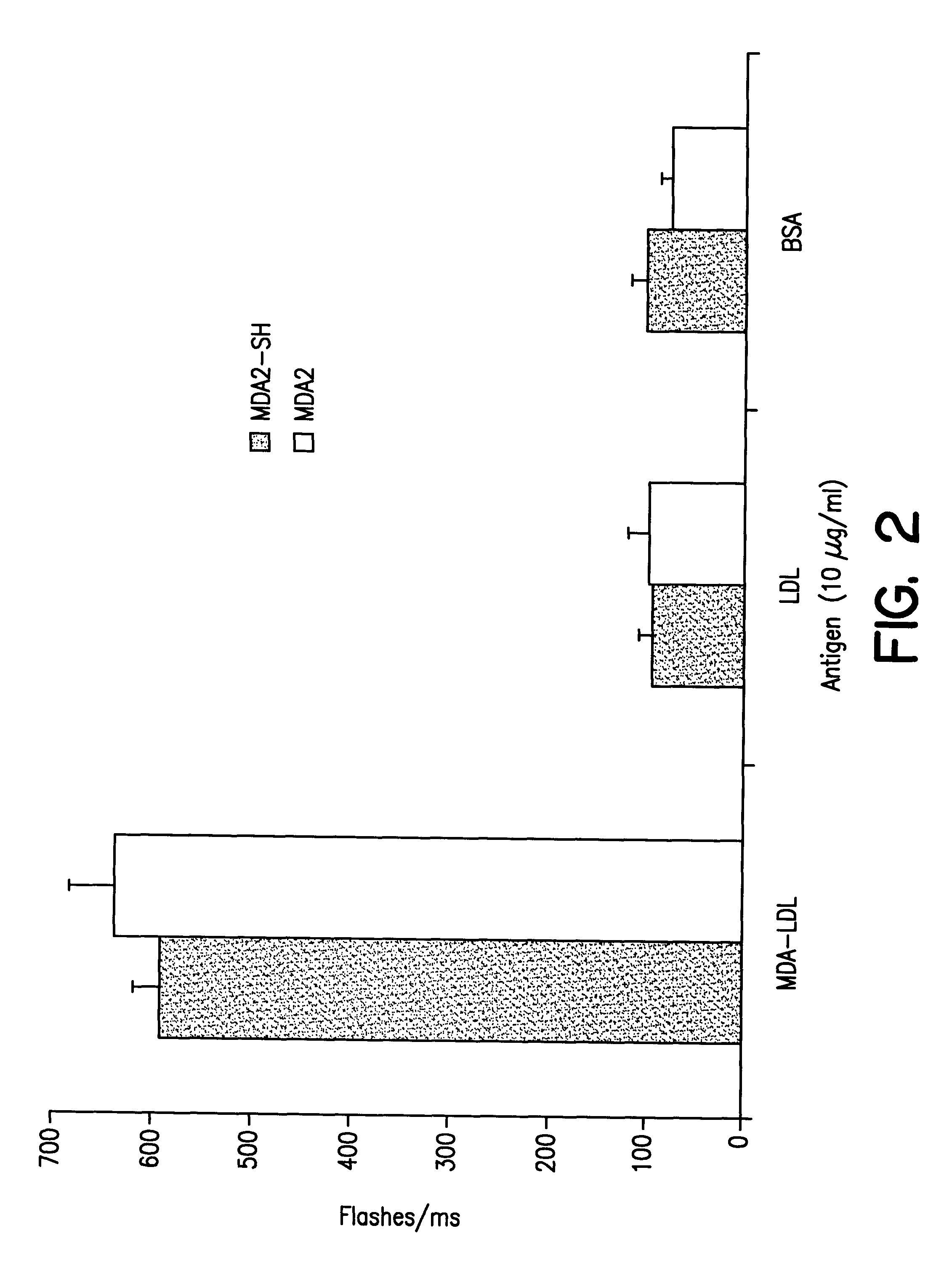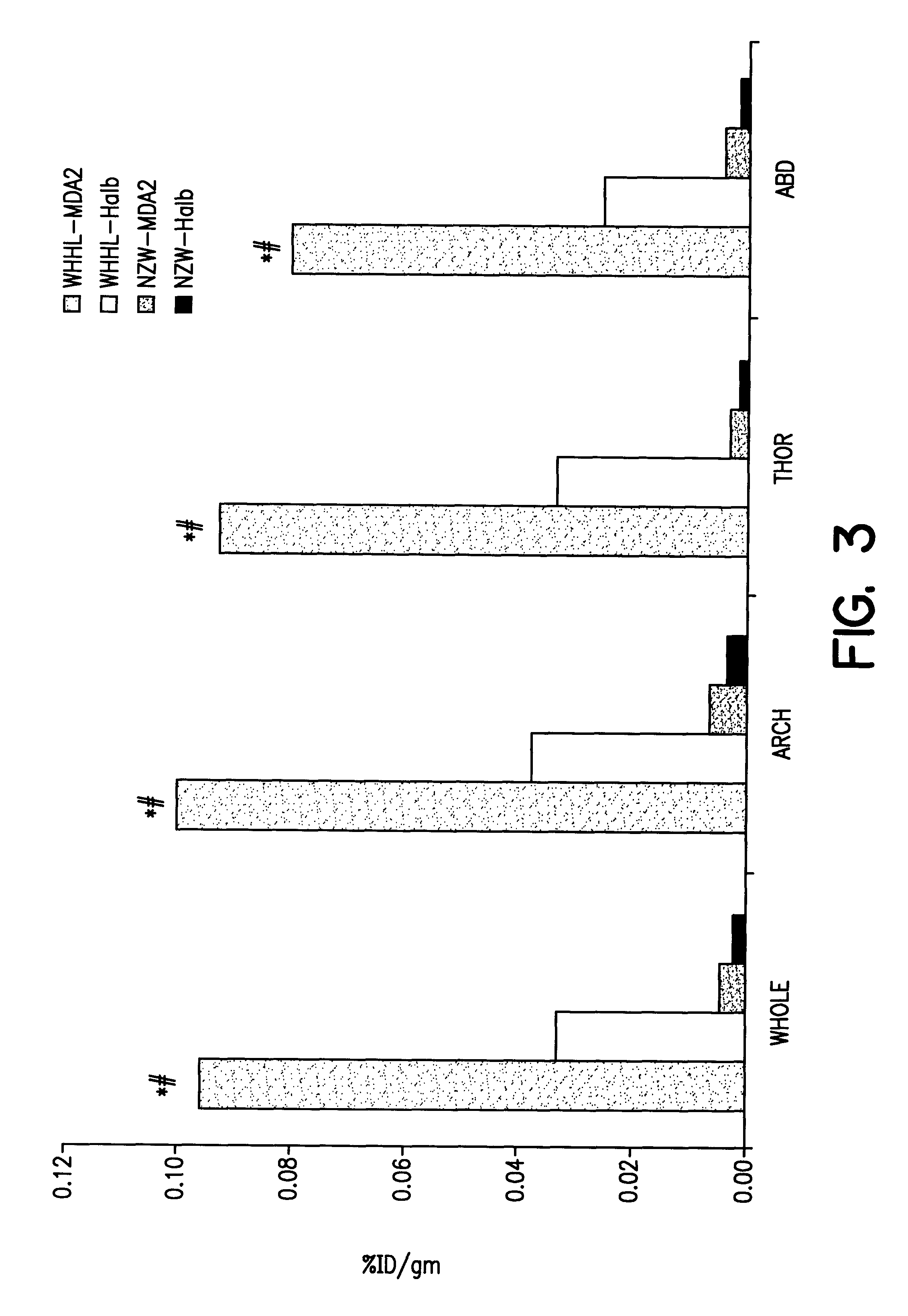Methods and reagents for non-invasive imaging of atherosclerotic plaque
- Summary
- Abstract
- Description
- Claims
- Application Information
AI Technical Summary
Problems solved by technology
Method used
Image
Examples
example ii
Antibody Radiolabeling
Iodination. MDA2 , NA59 and Halb were iodinated with the known lactoperoxidase / glucose oxidase method using a commercial kit (Enzymobead Radioiodination Reagent, BIORAD). Briefly, 200 .mu.g cold antibody in 50 .mu.l PBS was added to 200 .mu.l 0.2M phosphate buffer (pH 7.2), 50 .mu.l enzymobeads and 2 mCi .sup.125 I or .sup.131 I (20 .mu.l) followed by 50 .mu.l 2% .beta.-Dglucose. The reaction was gently vortexed and allowed to proceed at room temperature for 25 minutes. The beads were pelleted by ultracentrifugation at 2500 rpm for 5 minutes. The supernatant was extensively dialyzed in 4 liters PBS at 4.degree. C. with changes every 6 hours over a 24-hour period. Greater than 99% of .sup.125 I-MDA2 was precipitated by trichloroacetic acid (TCA) proving the purity of the radiolabel. The specific activity was approximately 3000 cpm / ng. Approximately 90 .mu.Ci (50-100 .mu.g) were injected in each experiment. Specificity for MDA-LDL was not affected by radiolabelin...
example iii
MDA-LDL Synthesis and Modification of LDL and Albumin With Malondialdehyde
LDL was prepared by ultracentrifugation in the presence of antioxidants and protease inhibitors. MDA-LDL was prepared by incubating LDL for 3 hours at 37.degree. C. with 0.5 M malondialdehyde at a constant ratio of 100 .mu.l / mg of LDL. 0.5 M malondialdehyde was freshly generated from malonaldehyde bis dimethylacetal by acid hydrolysis. After conjugation, MDA-LDL was extensively dialyzed against PBS to remove any unreacted MDA. The degree of MDA-modification was determined b conventional trinitrobenzenesulfonic acid assay and averaged 75% of the lysine residues. In addition, the electrophoretic mobility of the modified lipoproteins was compared to that of native LDL by electrophoresis using 1% agarose gels in borate buffer pH 8.6. Albumin was modified with MDA in a similar fashion.
example iv
Animal Model and Protocol
Rabbit model. Seventeen WHHL and 4 NZW rabbits, both on a regular diet, were used for the experiments. The mean age of the WHHL was 1.5.+-.1.0 years and for the NZW 6.+-.0.0 months. Mean weight was 3.1.+-.0.3 kg for all rabbits. WHHL spontaneously develop atherosclerosis without cholesterol feeding and have total cholesterol levels of 800-1200 mg / dl. They develop both coronary and aortic atherosclerosis. In this study we evaluated aortic lesions only. NZW rabbits were atherosclerosis free.
Injection protocol. The rabbits were intravenously injected one hour prior to each experiment with 1 mg / kg sodium iodine to reduce thyroid uptake of the iodinated radiolabel. The radiolabeled antibodies were drawn up into a 1 ml glass syringe without dead volume and direct injections of 0.25-0.5 ml were carried out through a marginal ear vein using a 23 gauge needle. After injection, blood was drawn into the syringe and reinjected several times to insure adequate injection ...
PUM
| Property | Measurement | Unit |
|---|---|---|
| Weight | aaaaa | aaaaa |
| Radioactivity | aaaaa | aaaaa |
| Paramagnetism | aaaaa | aaaaa |
Abstract
Description
Claims
Application Information
 Login to View More
Login to View More - R&D
- Intellectual Property
- Life Sciences
- Materials
- Tech Scout
- Unparalleled Data Quality
- Higher Quality Content
- 60% Fewer Hallucinations
Browse by: Latest US Patents, China's latest patents, Technical Efficacy Thesaurus, Application Domain, Technology Topic, Popular Technical Reports.
© 2025 PatSnap. All rights reserved.Legal|Privacy policy|Modern Slavery Act Transparency Statement|Sitemap|About US| Contact US: help@patsnap.com



